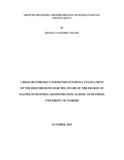| dc.description.abstract | This is a research project on the growth strategies and performance of hotels in Kwale
County, Kenya. The objectives of the research were to find out the growth strategies adopted
by hotels in Kwale County using the Ansoff growth model and to establish the relationship
between growth strategies and performance. Cross sectional survey was adopted as the
research design and it focused on all the 32 vocational hotels within Kwale County. The data
was mainly primary data and it was collected by use of close ended questionnaire with some
few open ended questions for elaboration purposes. The questionnaires were dropped and
later picked from the respondents who comprised of the general managers, Assistant
Managers, Operations manager and financial controllers of hotels within Kwale County
depending with who was available during the dropping time. The above were targeted as they
are the once who are directly concerned with decision making on growth strategies and
performance management in hotels. The researcher used descriptive design to find out the
growth strategies adopted and the relation between growth strategies and performance. The
response rate was 90.63 % as 29 out of 32 respondents successfully filled the questionnaires.
Descriptive statistics were used to summarize the data and they include percentages,
frequencies, and bar graphs while qualitative analysis was done in prose. The findings
revealed that product development, market penetration and market development strategies
were the strategies adopted by majority of the hotels with a few adopting diversification
strategies. The relationship between the growth strategies adopted and performance was
determined through regression analysis where R was 0.628 implying that there was strong
positive relationship between growth strategies and performance. However, R2 showed that
only 39.4% of the variation in the performance of hotels in Kwale County could be explained
by the variation of the growth strategies which were product development, market
penetration, market development and diversification. From the regression model, none of the
aspects of product development, market penetration and market development growth
strategies is significant since all their p-values are greater than the level of significance of
0.05. It would therefore not be appropriate to use this model to predict performance of hotels
in Kwale County because all the individual parameters were not significant in explaining the
performance. | en_US |

